Analysis of Leadership, Talent, and Training in NHS Management
VerifiedAdded on 2020/10/22
|10
|2550
|407
Report
AI Summary
This report provides a comprehensive analysis of leadership, talent management, and training and development within the National Health Service (NHS). It explores key theoretical models such as the PDCA Model, Hudson Leadership Model, Instructional System Development (ISD) Model, and the 5 B’s Talent Management Model, illustrating their application to current NHS scenarios. The report examines the roles and priorities of NHS management, emphasizing financial planning, market analysis, and employee motivation. Furthermore, it details the HR functions supporting management, including qualified recruitments and maintaining employee relations. The report also identifies internal and external influences impacting these areas, such as labor turnover and external training agencies. Finally, it offers relevant recommendations, including the use of flexible working environments, regular communication, and strategic hiring practices to enhance leadership, talent management, and employee satisfaction within the NHS.
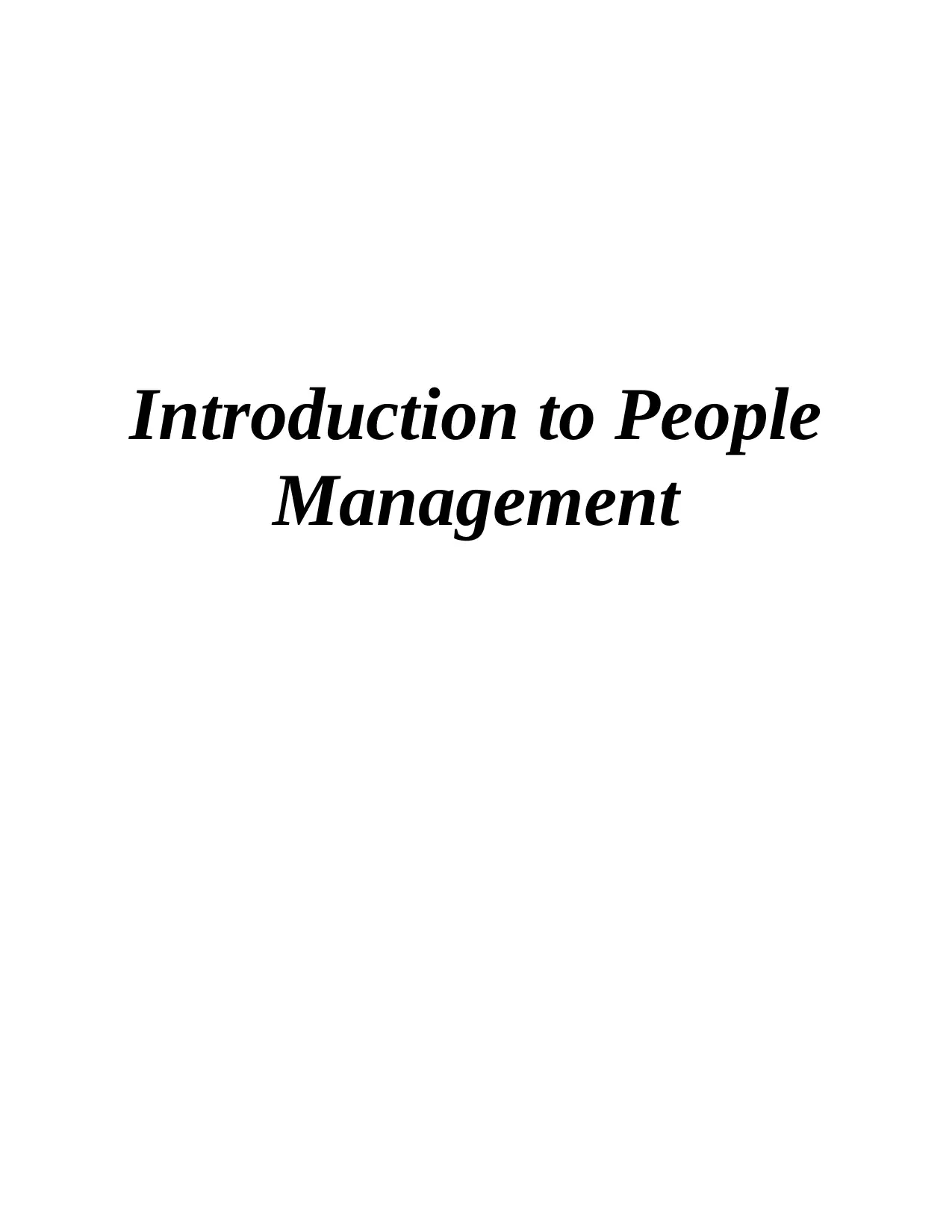
Introduction to People
Management
Management
Paraphrase This Document
Need a fresh take? Get an instant paraphrase of this document with our AI Paraphraser
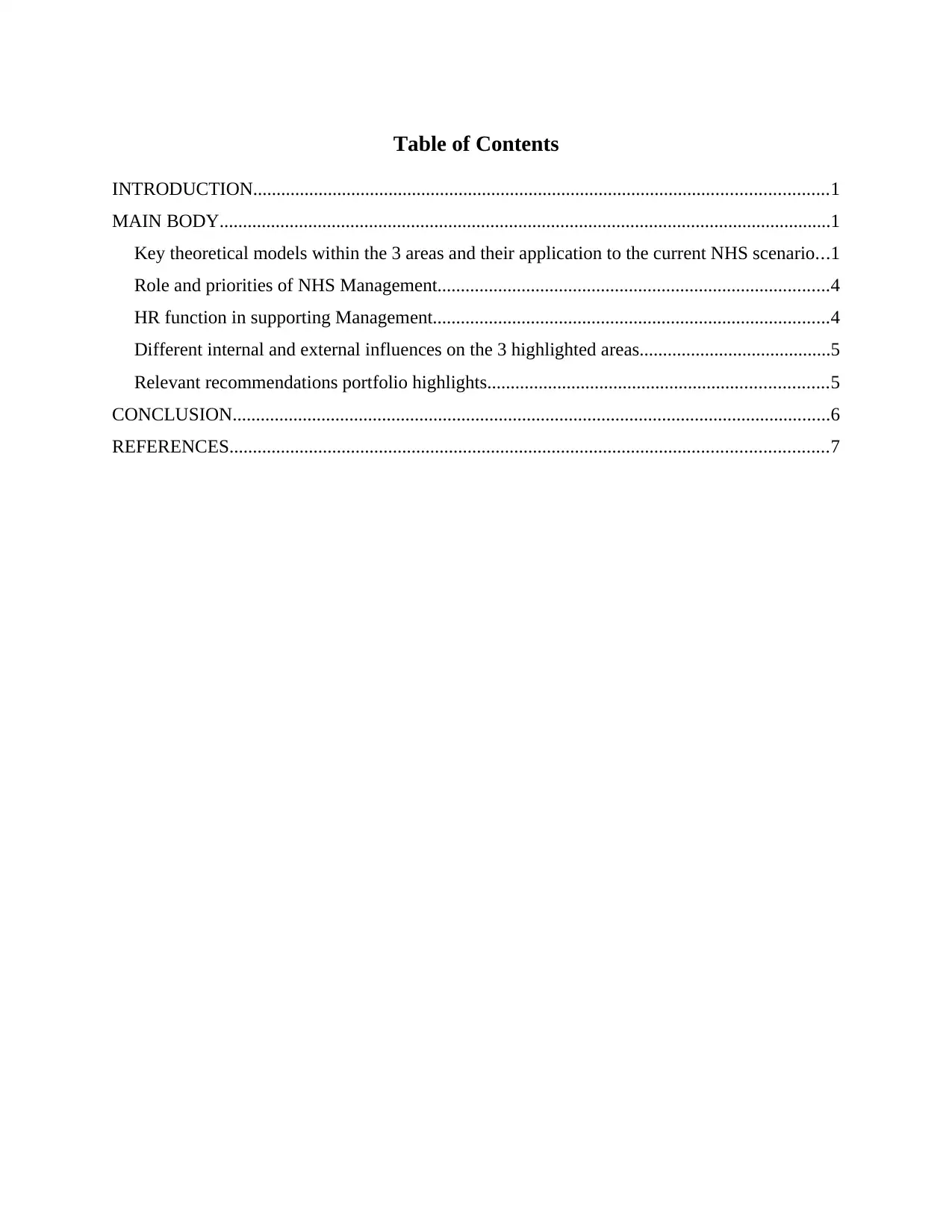
Table of Contents
INTRODUCTION...........................................................................................................................1
MAIN BODY...................................................................................................................................1
Key theoretical models within the 3 areas and their application to the current NHS scenario...1
Role and priorities of NHS Management....................................................................................4
HR function in supporting Management.....................................................................................4
Different internal and external influences on the 3 highlighted areas.........................................5
Relevant recommendations portfolio highlights.........................................................................5
CONCLUSION................................................................................................................................6
REFERENCES................................................................................................................................7
INTRODUCTION...........................................................................................................................1
MAIN BODY...................................................................................................................................1
Key theoretical models within the 3 areas and their application to the current NHS scenario...1
Role and priorities of NHS Management....................................................................................4
HR function in supporting Management.....................................................................................4
Different internal and external influences on the 3 highlighted areas.........................................5
Relevant recommendations portfolio highlights.........................................................................5
CONCLUSION................................................................................................................................6
REFERENCES................................................................................................................................7

⊘ This is a preview!⊘
Do you want full access?
Subscribe today to unlock all pages.

Trusted by 1+ million students worldwide
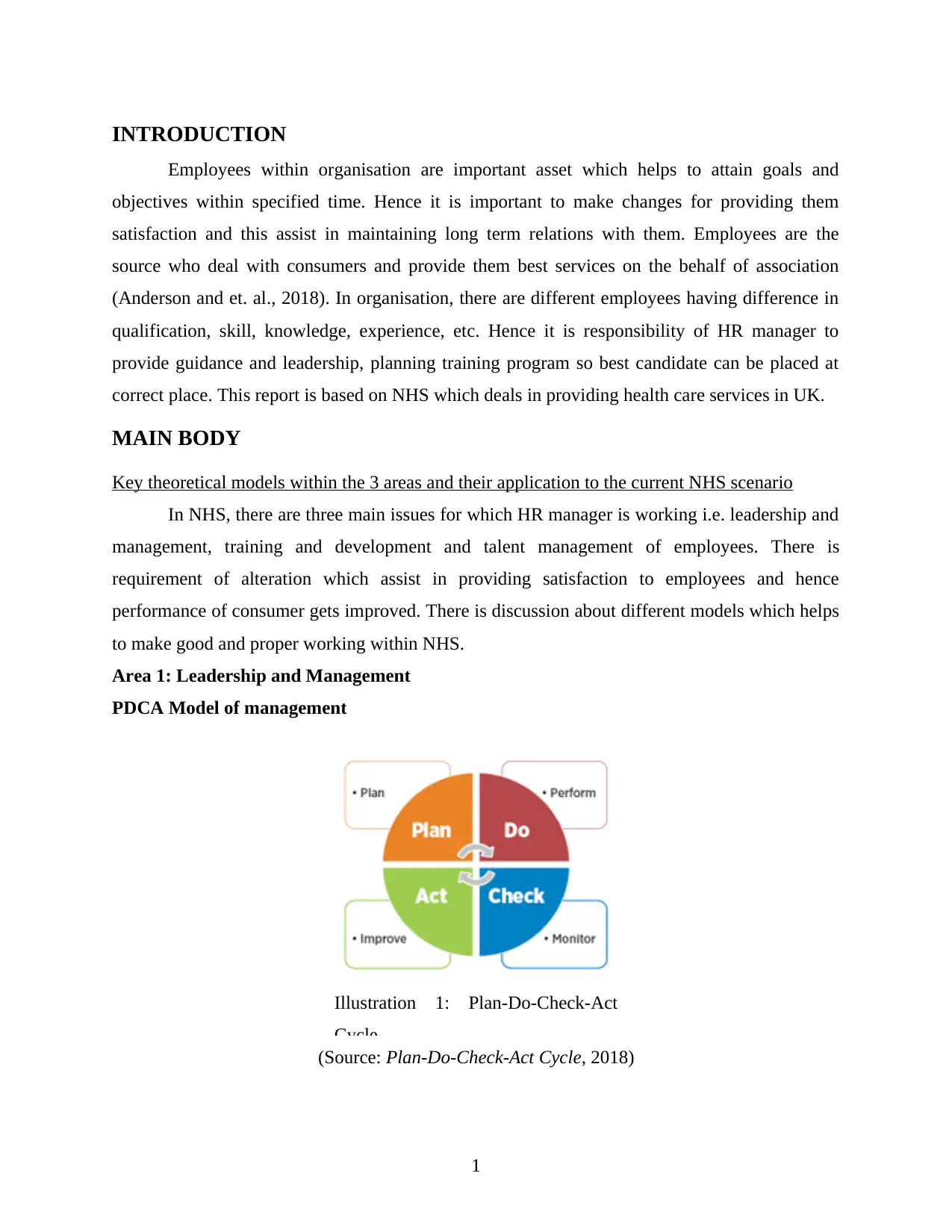
INTRODUCTION
Employees within organisation are important asset which helps to attain goals and
objectives within specified time. Hence it is important to make changes for providing them
satisfaction and this assist in maintaining long term relations with them. Employees are the
source who deal with consumers and provide them best services on the behalf of association
(Anderson and et. al., 2018). In organisation, there are different employees having difference in
qualification, skill, knowledge, experience, etc. Hence it is responsibility of HR manager to
provide guidance and leadership, planning training program so best candidate can be placed at
correct place. This report is based on NHS which deals in providing health care services in UK.
MAIN BODY
Key theoretical models within the 3 areas and their application to the current NHS scenario
In NHS, there are three main issues for which HR manager is working i.e. leadership and
management, training and development and talent management of employees. There is
requirement of alteration which assist in providing satisfaction to employees and hence
performance of consumer gets improved. There is discussion about different models which helps
to make good and proper working within NHS.
Area 1: Leadership and Management
PDCA Model of management
(Source: Plan-Do-Check-Act Cycle, 2018)
1
Illustration 1: Plan-Do-Check-Act
Cycle
Employees within organisation are important asset which helps to attain goals and
objectives within specified time. Hence it is important to make changes for providing them
satisfaction and this assist in maintaining long term relations with them. Employees are the
source who deal with consumers and provide them best services on the behalf of association
(Anderson and et. al., 2018). In organisation, there are different employees having difference in
qualification, skill, knowledge, experience, etc. Hence it is responsibility of HR manager to
provide guidance and leadership, planning training program so best candidate can be placed at
correct place. This report is based on NHS which deals in providing health care services in UK.
MAIN BODY
Key theoretical models within the 3 areas and their application to the current NHS scenario
In NHS, there are three main issues for which HR manager is working i.e. leadership and
management, training and development and talent management of employees. There is
requirement of alteration which assist in providing satisfaction to employees and hence
performance of consumer gets improved. There is discussion about different models which helps
to make good and proper working within NHS.
Area 1: Leadership and Management
PDCA Model of management
(Source: Plan-Do-Check-Act Cycle, 2018)
1
Illustration 1: Plan-Do-Check-Act
Cycle
Paraphrase This Document
Need a fresh take? Get an instant paraphrase of this document with our AI Paraphraser
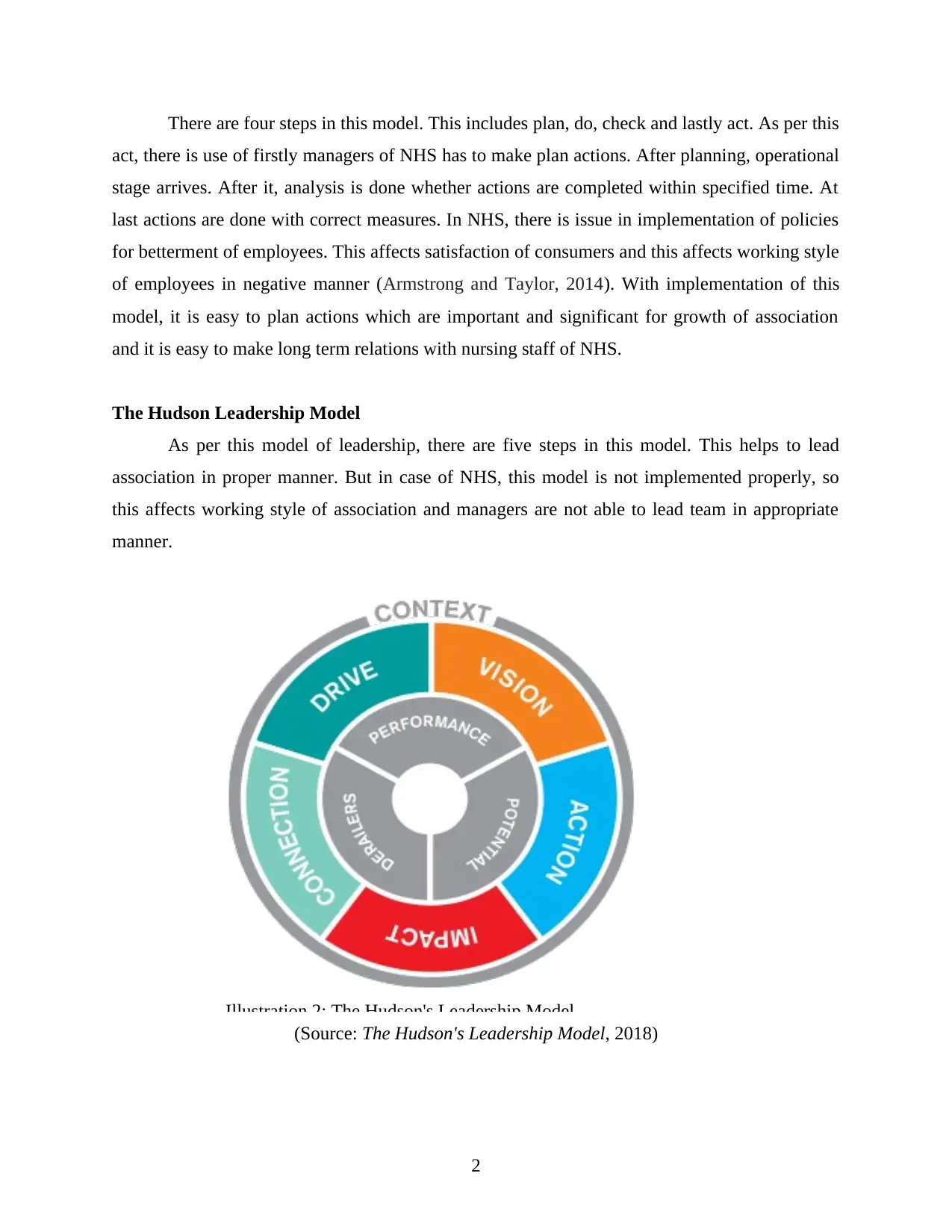
There are four steps in this model. This includes plan, do, check and lastly act. As per this
act, there is use of firstly managers of NHS has to make plan actions. After planning, operational
stage arrives. After it, analysis is done whether actions are completed within specified time. At
last actions are done with correct measures. In NHS, there is issue in implementation of policies
for betterment of employees. This affects satisfaction of consumers and this affects working style
of employees in negative manner (Armstrong and Taylor, 2014). With implementation of this
model, it is easy to plan actions which are important and significant for growth of association
and it is easy to make long term relations with nursing staff of NHS.
The Hudson Leadership Model
As per this model of leadership, there are five steps in this model. This helps to lead
association in proper manner. But in case of NHS, this model is not implemented properly, so
this affects working style of association and managers are not able to lead team in appropriate
manner.
(Source: The Hudson's Leadership Model, 2018)
2
Illustration 2: The Hudson's Leadership Model
act, there is use of firstly managers of NHS has to make plan actions. After planning, operational
stage arrives. After it, analysis is done whether actions are completed within specified time. At
last actions are done with correct measures. In NHS, there is issue in implementation of policies
for betterment of employees. This affects satisfaction of consumers and this affects working style
of employees in negative manner (Armstrong and Taylor, 2014). With implementation of this
model, it is easy to plan actions which are important and significant for growth of association
and it is easy to make long term relations with nursing staff of NHS.
The Hudson Leadership Model
As per this model of leadership, there are five steps in this model. This helps to lead
association in proper manner. But in case of NHS, this model is not implemented properly, so
this affects working style of association and managers are not able to lead team in appropriate
manner.
(Source: The Hudson's Leadership Model, 2018)
2
Illustration 2: The Hudson's Leadership Model
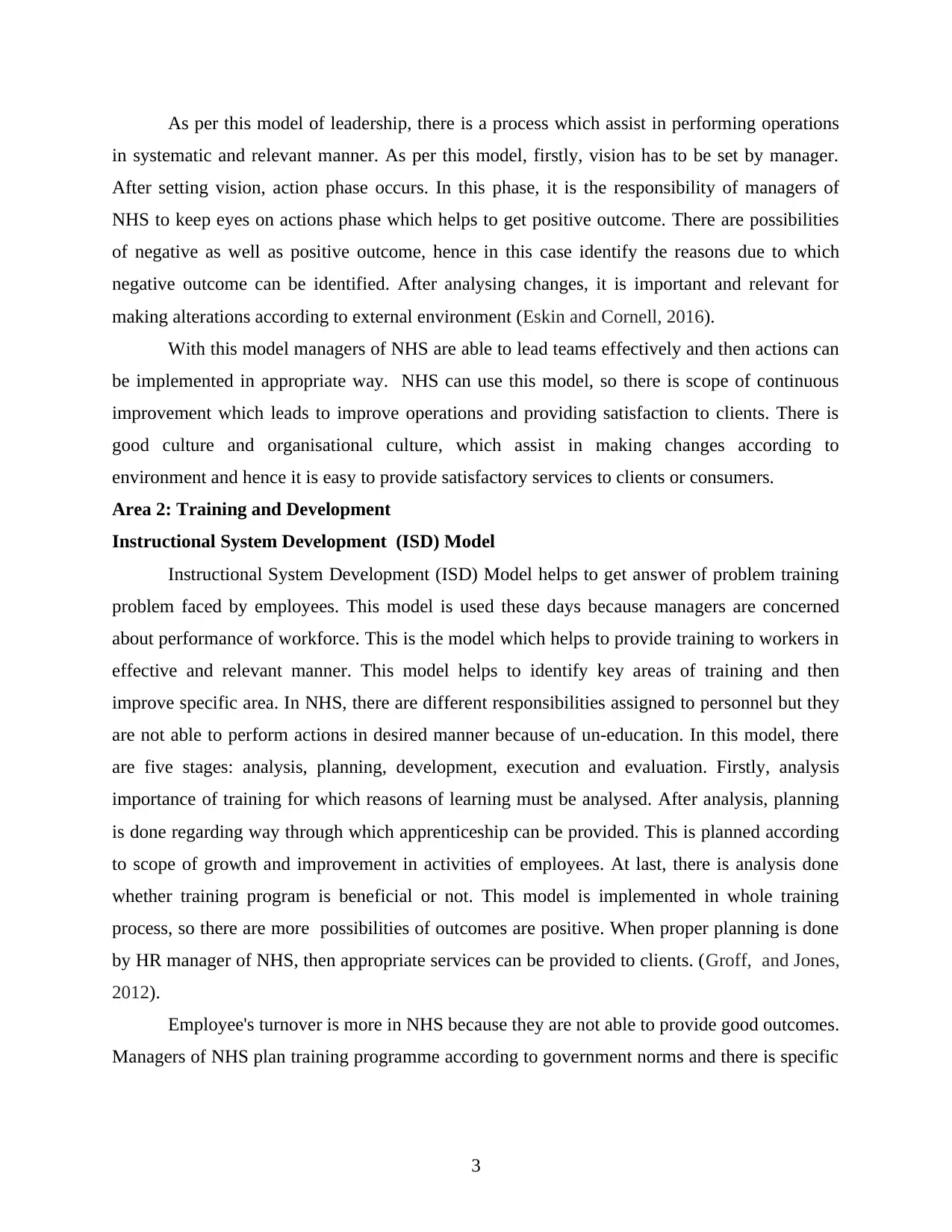
As per this model of leadership, there is a process which assist in performing operations
in systematic and relevant manner. As per this model, firstly, vision has to be set by manager.
After setting vision, action phase occurs. In this phase, it is the responsibility of managers of
NHS to keep eyes on actions phase which helps to get positive outcome. There are possibilities
of negative as well as positive outcome, hence in this case identify the reasons due to which
negative outcome can be identified. After analysing changes, it is important and relevant for
making alterations according to external environment (Eskin and Cornell, 2016).
With this model managers of NHS are able to lead teams effectively and then actions can
be implemented in appropriate way. NHS can use this model, so there is scope of continuous
improvement which leads to improve operations and providing satisfaction to clients. There is
good culture and organisational culture, which assist in making changes according to
environment and hence it is easy to provide satisfactory services to clients or consumers.
Area 2: Training and Development
Instructional System Development (ISD) Model
Instructional System Development (ISD) Model helps to get answer of problem training
problem faced by employees. This model is used these days because managers are concerned
about performance of workforce. This is the model which helps to provide training to workers in
effective and relevant manner. This model helps to identify key areas of training and then
improve specific area. In NHS, there are different responsibilities assigned to personnel but they
are not able to perform actions in desired manner because of un-education. In this model, there
are five stages: analysis, planning, development, execution and evaluation. Firstly, analysis
importance of training for which reasons of learning must be analysed. After analysis, planning
is done regarding way through which apprenticeship can be provided. This is planned according
to scope of growth and improvement in activities of employees. At last, there is analysis done
whether training program is beneficial or not. This model is implemented in whole training
process, so there are more possibilities of outcomes are positive. When proper planning is done
by HR manager of NHS, then appropriate services can be provided to clients. (Groff, and Jones,
2012).
Employee's turnover is more in NHS because they are not able to provide good outcomes.
Managers of NHS plan training programme according to government norms and there is specific
3
in systematic and relevant manner. As per this model, firstly, vision has to be set by manager.
After setting vision, action phase occurs. In this phase, it is the responsibility of managers of
NHS to keep eyes on actions phase which helps to get positive outcome. There are possibilities
of negative as well as positive outcome, hence in this case identify the reasons due to which
negative outcome can be identified. After analysing changes, it is important and relevant for
making alterations according to external environment (Eskin and Cornell, 2016).
With this model managers of NHS are able to lead teams effectively and then actions can
be implemented in appropriate way. NHS can use this model, so there is scope of continuous
improvement which leads to improve operations and providing satisfaction to clients. There is
good culture and organisational culture, which assist in making changes according to
environment and hence it is easy to provide satisfactory services to clients or consumers.
Area 2: Training and Development
Instructional System Development (ISD) Model
Instructional System Development (ISD) Model helps to get answer of problem training
problem faced by employees. This model is used these days because managers are concerned
about performance of workforce. This is the model which helps to provide training to workers in
effective and relevant manner. This model helps to identify key areas of training and then
improve specific area. In NHS, there are different responsibilities assigned to personnel but they
are not able to perform actions in desired manner because of un-education. In this model, there
are five stages: analysis, planning, development, execution and evaluation. Firstly, analysis
importance of training for which reasons of learning must be analysed. After analysis, planning
is done regarding way through which apprenticeship can be provided. This is planned according
to scope of growth and improvement in activities of employees. At last, there is analysis done
whether training program is beneficial or not. This model is implemented in whole training
process, so there are more possibilities of outcomes are positive. When proper planning is done
by HR manager of NHS, then appropriate services can be provided to clients. (Groff, and Jones,
2012).
Employee's turnover is more in NHS because they are not able to provide good outcomes.
Managers of NHS plan training programme according to government norms and there is specific
3
⊘ This is a preview!⊘
Do you want full access?
Subscribe today to unlock all pages.

Trusted by 1+ million students worldwide
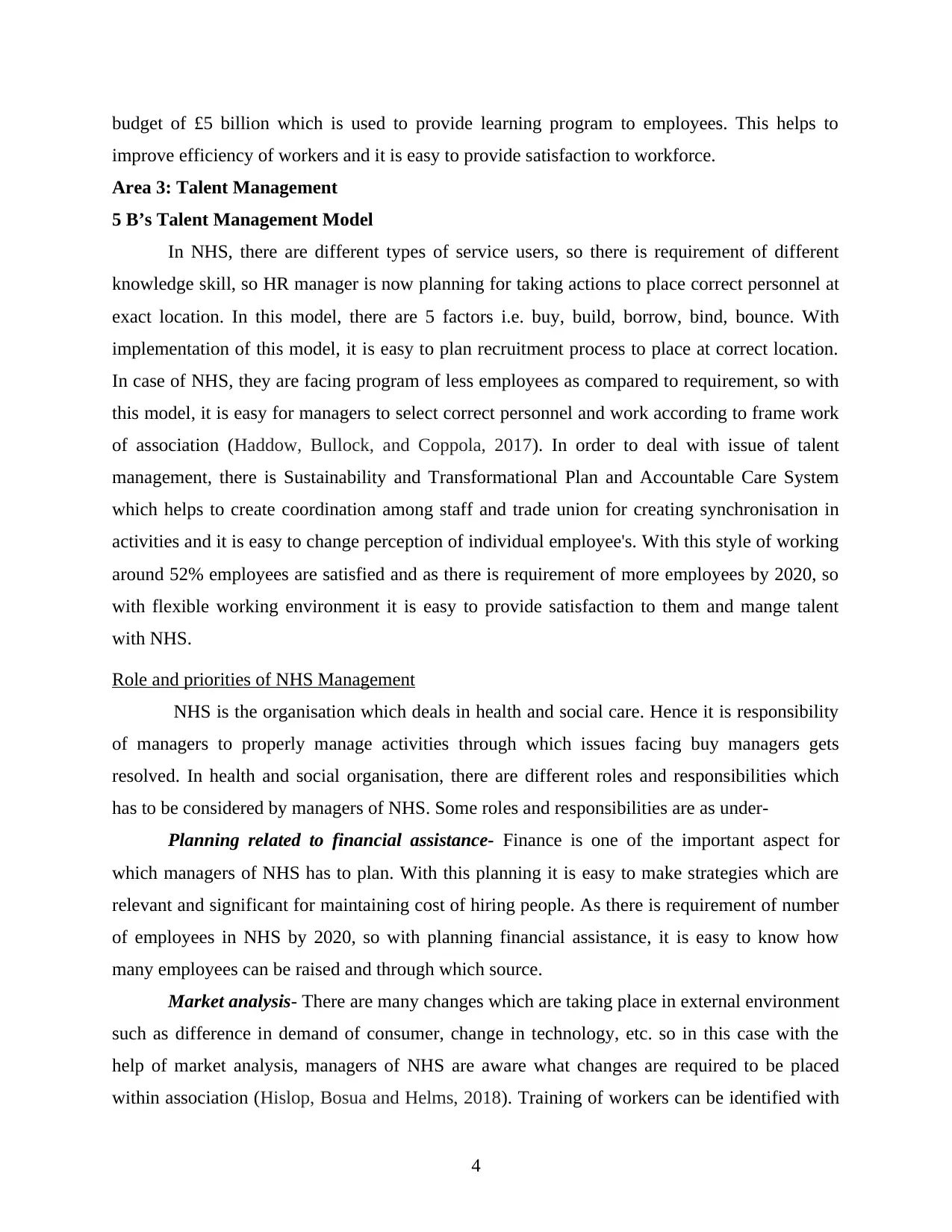
budget of £5 billion which is used to provide learning program to employees. This helps to
improve efficiency of workers and it is easy to provide satisfaction to workforce.
Area 3: Talent Management
5 B’s Talent Management Model
In NHS, there are different types of service users, so there is requirement of different
knowledge skill, so HR manager is now planning for taking actions to place correct personnel at
exact location. In this model, there are 5 factors i.e. buy, build, borrow, bind, bounce. With
implementation of this model, it is easy to plan recruitment process to place at correct location.
In case of NHS, they are facing program of less employees as compared to requirement, so with
this model, it is easy for managers to select correct personnel and work according to frame work
of association (Haddow, Bullock, and Coppola, 2017). In order to deal with issue of talent
management, there is Sustainability and Transformational Plan and Accountable Care System
which helps to create coordination among staff and trade union for creating synchronisation in
activities and it is easy to change perception of individual employee's. With this style of working
around 52% employees are satisfied and as there is requirement of more employees by 2020, so
with flexible working environment it is easy to provide satisfaction to them and mange talent
with NHS.
Role and priorities of NHS Management
NHS is the organisation which deals in health and social care. Hence it is responsibility
of managers to properly manage activities through which issues facing buy managers gets
resolved. In health and social organisation, there are different roles and responsibilities which
has to be considered by managers of NHS. Some roles and responsibilities are as under-
Planning related to financial assistance- Finance is one of the important aspect for
which managers of NHS has to plan. With this planning it is easy to make strategies which are
relevant and significant for maintaining cost of hiring people. As there is requirement of number
of employees in NHS by 2020, so with planning financial assistance, it is easy to know how
many employees can be raised and through which source.
Market analysis- There are many changes which are taking place in external environment
such as difference in demand of consumer, change in technology, etc. so in this case with the
help of market analysis, managers of NHS are aware what changes are required to be placed
within association (Hislop, Bosua and Helms, 2018). Training of workers can be identified with
4
improve efficiency of workers and it is easy to provide satisfaction to workforce.
Area 3: Talent Management
5 B’s Talent Management Model
In NHS, there are different types of service users, so there is requirement of different
knowledge skill, so HR manager is now planning for taking actions to place correct personnel at
exact location. In this model, there are 5 factors i.e. buy, build, borrow, bind, bounce. With
implementation of this model, it is easy to plan recruitment process to place at correct location.
In case of NHS, they are facing program of less employees as compared to requirement, so with
this model, it is easy for managers to select correct personnel and work according to frame work
of association (Haddow, Bullock, and Coppola, 2017). In order to deal with issue of talent
management, there is Sustainability and Transformational Plan and Accountable Care System
which helps to create coordination among staff and trade union for creating synchronisation in
activities and it is easy to change perception of individual employee's. With this style of working
around 52% employees are satisfied and as there is requirement of more employees by 2020, so
with flexible working environment it is easy to provide satisfaction to them and mange talent
with NHS.
Role and priorities of NHS Management
NHS is the organisation which deals in health and social care. Hence it is responsibility
of managers to properly manage activities through which issues facing buy managers gets
resolved. In health and social organisation, there are different roles and responsibilities which
has to be considered by managers of NHS. Some roles and responsibilities are as under-
Planning related to financial assistance- Finance is one of the important aspect for
which managers of NHS has to plan. With this planning it is easy to make strategies which are
relevant and significant for maintaining cost of hiring people. As there is requirement of number
of employees in NHS by 2020, so with planning financial assistance, it is easy to know how
many employees can be raised and through which source.
Market analysis- There are many changes which are taking place in external environment
such as difference in demand of consumer, change in technology, etc. so in this case with the
help of market analysis, managers of NHS are aware what changes are required to be placed
within association (Hislop, Bosua and Helms, 2018). Training of workers can be identified with
4
Paraphrase This Document
Need a fresh take? Get an instant paraphrase of this document with our AI Paraphraser
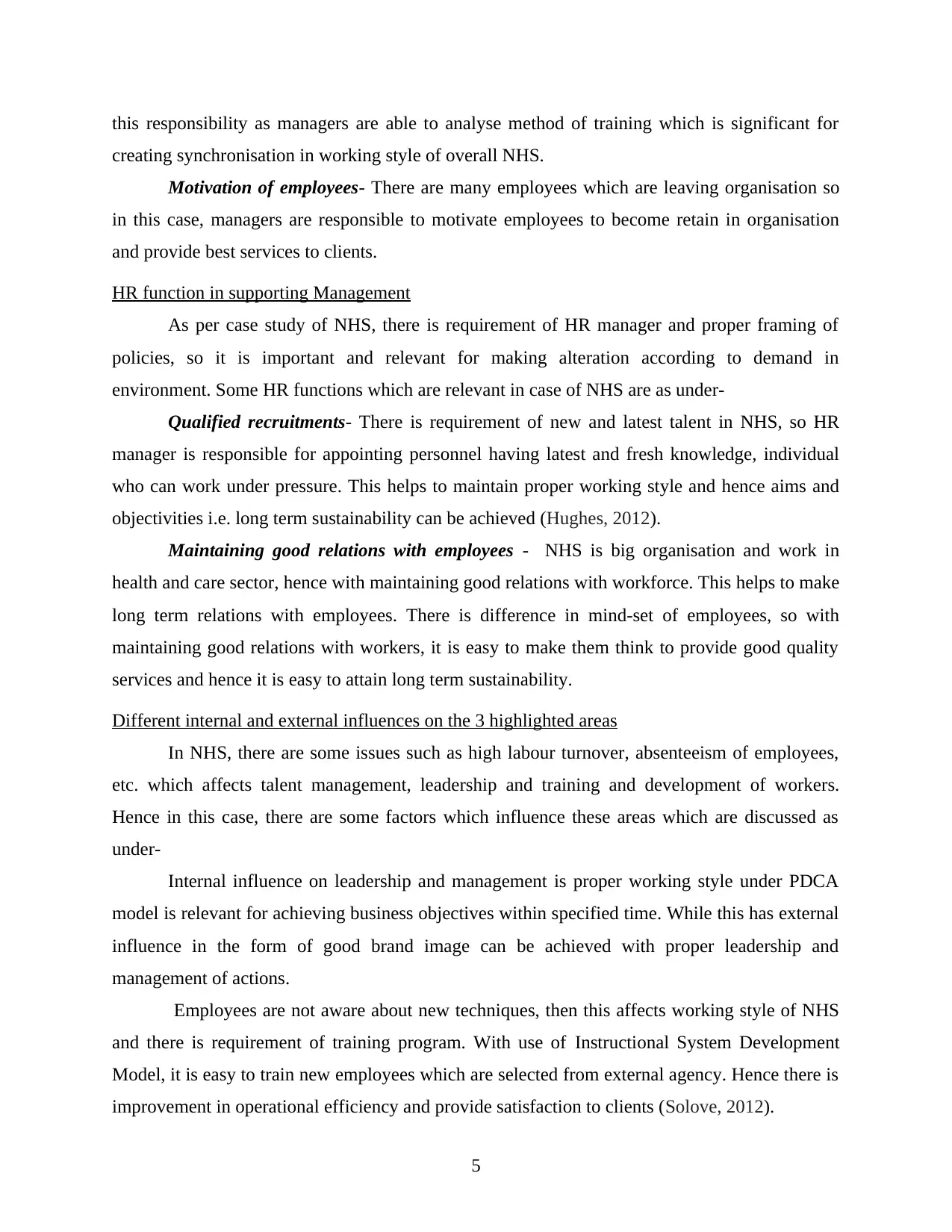
this responsibility as managers are able to analyse method of training which is significant for
creating synchronisation in working style of overall NHS.
Motivation of employees- There are many employees which are leaving organisation so
in this case, managers are responsible to motivate employees to become retain in organisation
and provide best services to clients.
HR function in supporting Management
As per case study of NHS, there is requirement of HR manager and proper framing of
policies, so it is important and relevant for making alteration according to demand in
environment. Some HR functions which are relevant in case of NHS are as under-
Qualified recruitments- There is requirement of new and latest talent in NHS, so HR
manager is responsible for appointing personnel having latest and fresh knowledge, individual
who can work under pressure. This helps to maintain proper working style and hence aims and
objectivities i.e. long term sustainability can be achieved (Hughes, 2012).
Maintaining good relations with employees - NHS is big organisation and work in
health and care sector, hence with maintaining good relations with workforce. This helps to make
long term relations with employees. There is difference in mind-set of employees, so with
maintaining good relations with workers, it is easy to make them think to provide good quality
services and hence it is easy to attain long term sustainability.
Different internal and external influences on the 3 highlighted areas
In NHS, there are some issues such as high labour turnover, absenteeism of employees,
etc. which affects talent management, leadership and training and development of workers.
Hence in this case, there are some factors which influence these areas which are discussed as
under-
Internal influence on leadership and management is proper working style under PDCA
model is relevant for achieving business objectives within specified time. While this has external
influence in the form of good brand image can be achieved with proper leadership and
management of actions.
Employees are not aware about new techniques, then this affects working style of NHS
and there is requirement of training program. With use of Instructional System Development
Model, it is easy to train new employees which are selected from external agency. Hence there is
improvement in operational efficiency and provide satisfaction to clients (Solove, 2012).
5
creating synchronisation in working style of overall NHS.
Motivation of employees- There are many employees which are leaving organisation so
in this case, managers are responsible to motivate employees to become retain in organisation
and provide best services to clients.
HR function in supporting Management
As per case study of NHS, there is requirement of HR manager and proper framing of
policies, so it is important and relevant for making alteration according to demand in
environment. Some HR functions which are relevant in case of NHS are as under-
Qualified recruitments- There is requirement of new and latest talent in NHS, so HR
manager is responsible for appointing personnel having latest and fresh knowledge, individual
who can work under pressure. This helps to maintain proper working style and hence aims and
objectivities i.e. long term sustainability can be achieved (Hughes, 2012).
Maintaining good relations with employees - NHS is big organisation and work in
health and care sector, hence with maintaining good relations with workforce. This helps to make
long term relations with employees. There is difference in mind-set of employees, so with
maintaining good relations with workers, it is easy to make them think to provide good quality
services and hence it is easy to attain long term sustainability.
Different internal and external influences on the 3 highlighted areas
In NHS, there are some issues such as high labour turnover, absenteeism of employees,
etc. which affects talent management, leadership and training and development of workers.
Hence in this case, there are some factors which influence these areas which are discussed as
under-
Internal influence on leadership and management is proper working style under PDCA
model is relevant for achieving business objectives within specified time. While this has external
influence in the form of good brand image can be achieved with proper leadership and
management of actions.
Employees are not aware about new techniques, then this affects working style of NHS
and there is requirement of training program. With use of Instructional System Development
Model, it is easy to train new employees which are selected from external agency. Hence there is
improvement in operational efficiency and provide satisfaction to clients (Solove, 2012).
5
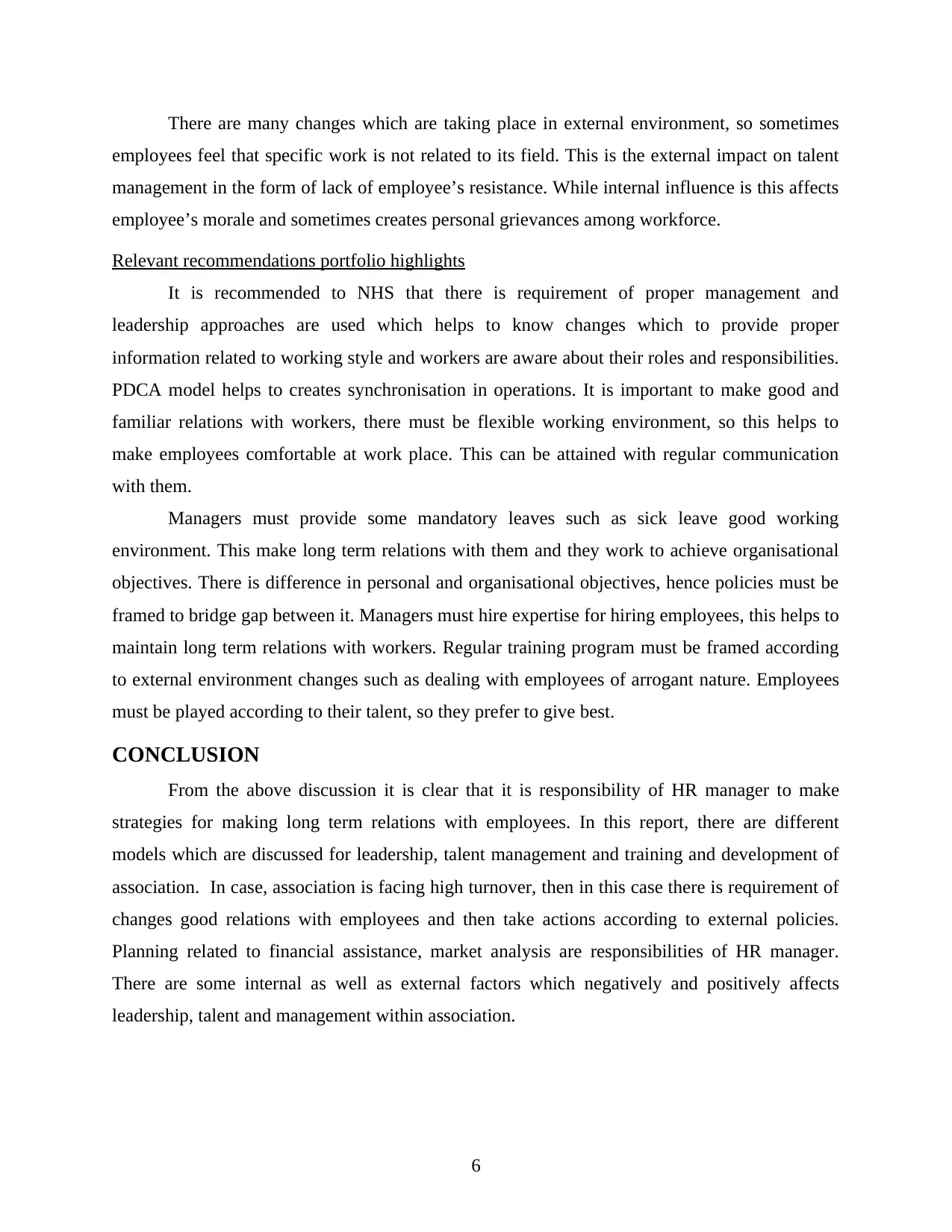
There are many changes which are taking place in external environment, so sometimes
employees feel that specific work is not related to its field. This is the external impact on talent
management in the form of lack of employee’s resistance. While internal influence is this affects
employee’s morale and sometimes creates personal grievances among workforce.
Relevant recommendations portfolio highlights
It is recommended to NHS that there is requirement of proper management and
leadership approaches are used which helps to know changes which to provide proper
information related to working style and workers are aware about their roles and responsibilities.
PDCA model helps to creates synchronisation in operations. It is important to make good and
familiar relations with workers, there must be flexible working environment, so this helps to
make employees comfortable at work place. This can be attained with regular communication
with them.
Managers must provide some mandatory leaves such as sick leave good working
environment. This make long term relations with them and they work to achieve organisational
objectives. There is difference in personal and organisational objectives, hence policies must be
framed to bridge gap between it. Managers must hire expertise for hiring employees, this helps to
maintain long term relations with workers. Regular training program must be framed according
to external environment changes such as dealing with employees of arrogant nature. Employees
must be played according to their talent, so they prefer to give best.
CONCLUSION
From the above discussion it is clear that it is responsibility of HR manager to make
strategies for making long term relations with employees. In this report, there are different
models which are discussed for leadership, talent management and training and development of
association. In case, association is facing high turnover, then in this case there is requirement of
changes good relations with employees and then take actions according to external policies.
Planning related to financial assistance, market analysis are responsibilities of HR manager.
There are some internal as well as external factors which negatively and positively affects
leadership, talent and management within association.
6
employees feel that specific work is not related to its field. This is the external impact on talent
management in the form of lack of employee’s resistance. While internal influence is this affects
employee’s morale and sometimes creates personal grievances among workforce.
Relevant recommendations portfolio highlights
It is recommended to NHS that there is requirement of proper management and
leadership approaches are used which helps to know changes which to provide proper
information related to working style and workers are aware about their roles and responsibilities.
PDCA model helps to creates synchronisation in operations. It is important to make good and
familiar relations with workers, there must be flexible working environment, so this helps to
make employees comfortable at work place. This can be attained with regular communication
with them.
Managers must provide some mandatory leaves such as sick leave good working
environment. This make long term relations with them and they work to achieve organisational
objectives. There is difference in personal and organisational objectives, hence policies must be
framed to bridge gap between it. Managers must hire expertise for hiring employees, this helps to
maintain long term relations with workers. Regular training program must be framed according
to external environment changes such as dealing with employees of arrogant nature. Employees
must be played according to their talent, so they prefer to give best.
CONCLUSION
From the above discussion it is clear that it is responsibility of HR manager to make
strategies for making long term relations with employees. In this report, there are different
models which are discussed for leadership, talent management and training and development of
association. In case, association is facing high turnover, then in this case there is requirement of
changes good relations with employees and then take actions according to external policies.
Planning related to financial assistance, market analysis are responsibilities of HR manager.
There are some internal as well as external factors which negatively and positively affects
leadership, talent and management within association.
6
⊘ This is a preview!⊘
Do you want full access?
Subscribe today to unlock all pages.

Trusted by 1+ million students worldwide
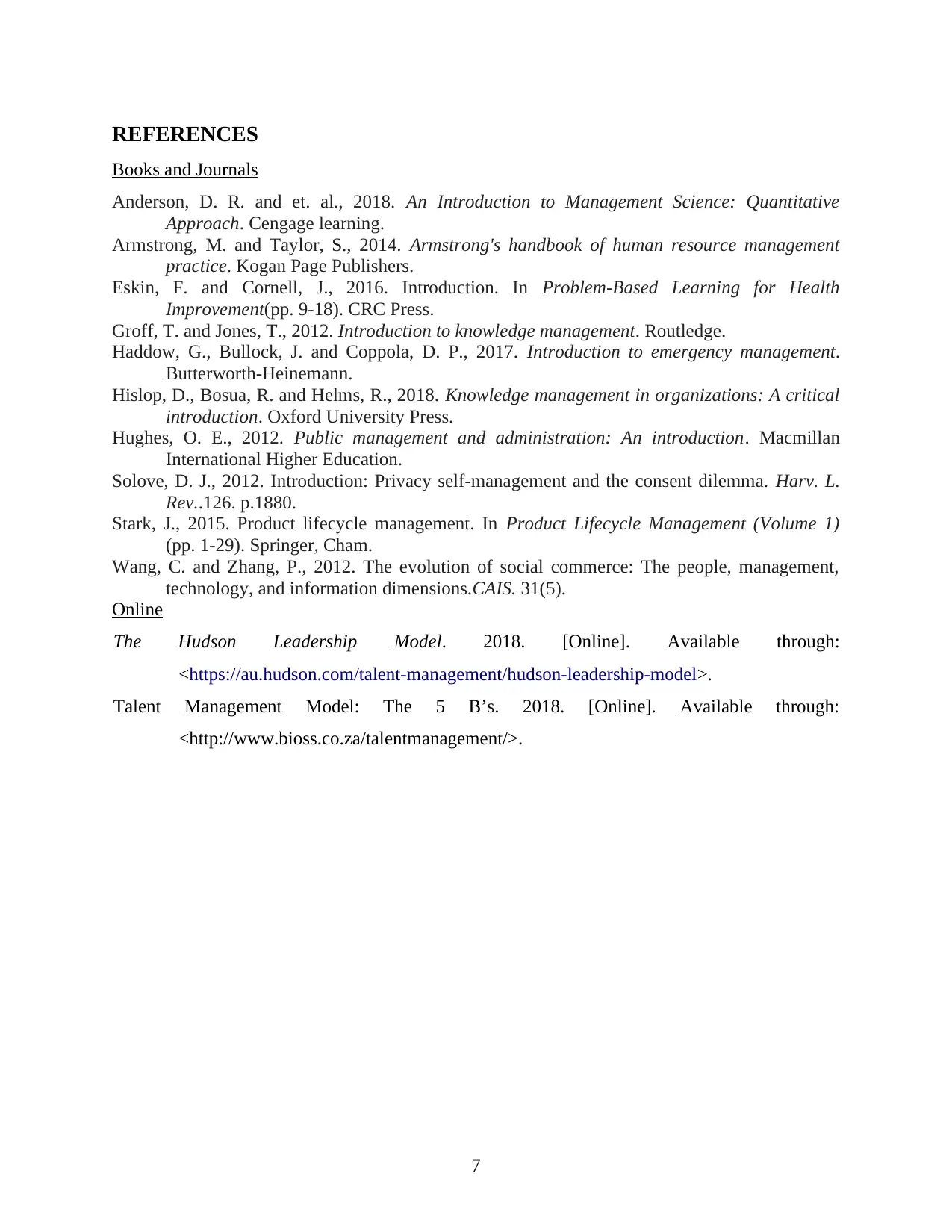
REFERENCES
Books and Journals
Anderson, D. R. and et. al., 2018. An Introduction to Management Science: Quantitative
Approach. Cengage learning.
Armstrong, M. and Taylor, S., 2014. Armstrong's handbook of human resource management
practice. Kogan Page Publishers.
Eskin, F. and Cornell, J., 2016. Introduction. In Problem-Based Learning for Health
Improvement(pp. 9-18). CRC Press.
Groff, T. and Jones, T., 2012. Introduction to knowledge management. Routledge.
Haddow, G., Bullock, J. and Coppola, D. P., 2017. Introduction to emergency management.
Butterworth-Heinemann.
Hislop, D., Bosua, R. and Helms, R., 2018. Knowledge management in organizations: A critical
introduction. Oxford University Press.
Hughes, O. E., 2012. Public management and administration: An introduction. Macmillan
International Higher Education.
Solove, D. J., 2012. Introduction: Privacy self-management and the consent dilemma. Harv. L.
Rev..126. p.1880.
Stark, J., 2015. Product lifecycle management. In Product Lifecycle Management (Volume 1)
(pp. 1-29). Springer, Cham.
Wang, C. and Zhang, P., 2012. The evolution of social commerce: The people, management,
technology, and information dimensions.CAIS. 31(5).
Online
The Hudson Leadership Model. 2018. [Online]. Available through:
<https://au.hudson.com/talent-management/hudson-leadership-model>.
Talent Management Model: The 5 B’s. 2018. [Online]. Available through:
<http://www.bioss.co.za/talentmanagement/>.
7
Books and Journals
Anderson, D. R. and et. al., 2018. An Introduction to Management Science: Quantitative
Approach. Cengage learning.
Armstrong, M. and Taylor, S., 2014. Armstrong's handbook of human resource management
practice. Kogan Page Publishers.
Eskin, F. and Cornell, J., 2016. Introduction. In Problem-Based Learning for Health
Improvement(pp. 9-18). CRC Press.
Groff, T. and Jones, T., 2012. Introduction to knowledge management. Routledge.
Haddow, G., Bullock, J. and Coppola, D. P., 2017. Introduction to emergency management.
Butterworth-Heinemann.
Hislop, D., Bosua, R. and Helms, R., 2018. Knowledge management in organizations: A critical
introduction. Oxford University Press.
Hughes, O. E., 2012. Public management and administration: An introduction. Macmillan
International Higher Education.
Solove, D. J., 2012. Introduction: Privacy self-management and the consent dilemma. Harv. L.
Rev..126. p.1880.
Stark, J., 2015. Product lifecycle management. In Product Lifecycle Management (Volume 1)
(pp. 1-29). Springer, Cham.
Wang, C. and Zhang, P., 2012. The evolution of social commerce: The people, management,
technology, and information dimensions.CAIS. 31(5).
Online
The Hudson Leadership Model. 2018. [Online]. Available through:
<https://au.hudson.com/talent-management/hudson-leadership-model>.
Talent Management Model: The 5 B’s. 2018. [Online]. Available through:
<http://www.bioss.co.za/talentmanagement/>.
7
1 out of 10
Related Documents
Your All-in-One AI-Powered Toolkit for Academic Success.
+13062052269
info@desklib.com
Available 24*7 on WhatsApp / Email
![[object Object]](/_next/static/media/star-bottom.7253800d.svg)
Unlock your academic potential
Copyright © 2020–2025 A2Z Services. All Rights Reserved. Developed and managed by ZUCOL.





